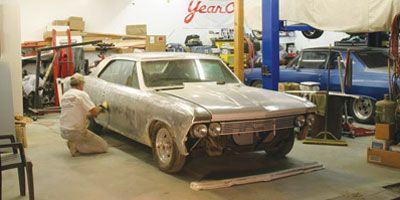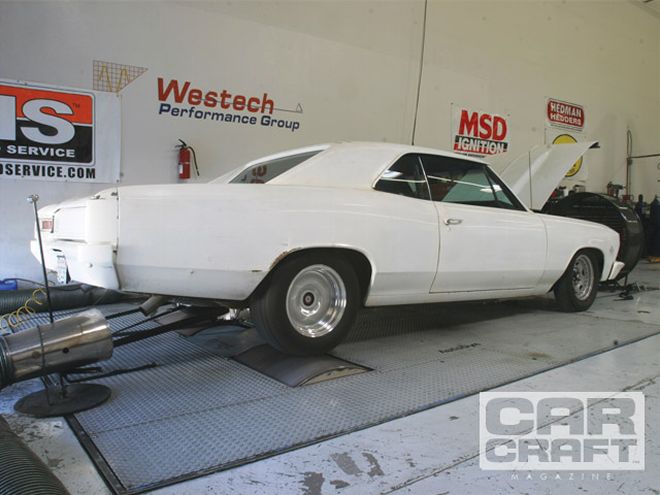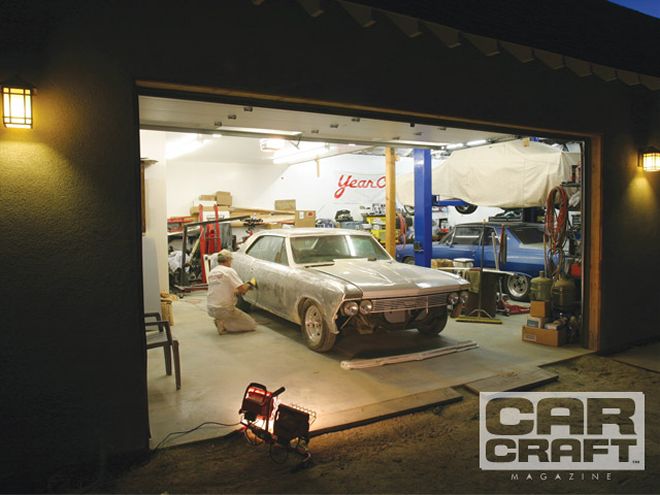
 This is what the Chevelle looked like on Westech's dyno when we did the rearend test ("The Great Rear Axle Comparo," June '08). What you can't see is the badly checked paint, dings, surface rust, and general paint malaise.
This is what the Chevelle looked like on Westech's dyno when we did the rearend test ("The Great Rear Axle Comparo," June '08). What you can't see is the badly checked paint, dings, surface rust, and general paint malaise.
It was inevitable. Our white '66 Chevelle faced a serious image problem. No, we're not in danger of appearing on some sleazy entertainment program like TMZ any time soon. But if the Fox channel did care, they'd notice that the A-body's paint has seen better days. Editor Glad finally had enough of its monochromatic visage. "Do us all a favor and de-'80s that thing," came the cry from the editor's chair--and he was right. The Chevelle was way past due for a makeover--mainly because of the many hard miles since the late '80s, when Scott Sullivan dipped the whole car in black and white lacquer. During the last 20 years, it has served as a cross-country runner and daily transportation for the fledgling Smith kids, suffered multiple indignities during countless grocery store parking lot skirmishes, was gravely wounded with a broken motor and cracked A-arm in the '90s, and has slowly climbed out of the primordial ooze sporting a GM Performance Parts 383, a TCI 400 trans, a Strange S-60 Dana 60 rearend, and an Art Morrison 10-point rollbar. Unfortunately, these mechanical upgrades were still trapped in an ebony-and-ivory look that just screamed, "Hey, 1988 just called and it wants its Euro look back."

Since classic lines never go out of style, we decided to return to Chevelle roots with a little citrus flare. This is when we piled on the effort. The original lacquer was badly neglected with deep paint fissures and Bondo cracks that rivaled the Snake River Canyon. Our story begins with transforming clouds of Bondo dust into a new look with a wholesome Huggin' Orange glow. Damn that overspray....
Bring In The Strippers
The deep cracks in the paint demanded we drill down to parent metal, and some of the primer appeared damaged as well. We decided to strip the car to the metal because of the deep paint cracking over most of the horizontal surfaces. Plus, there are questions about compatibility between lacquers and today's urethane enamels. Totally stripping the car eliminates any potential problems. Most '60s muscle cars were painted with acrylic lacquers, and GM was the last major company to use lacquer through the mid-'80s, so the best guarantee to avoid problems is to remove all the old lacquer and primer when using modern paint. If the existing paint is an enamel, then you could get away with perhaps as many as three layers of paint if only because the new enamels tend to be more flexible than lacquers. You may have heard about the new water-based-type paints that are coming. According to our mentor, Mike Paradis, who teaches at West Valley Occupational Center in Woodland Hills, California, these can be used over existing solvent-based primers and with solvent-based clears. The big thing to remember is to use the same brand for all levels of paint product, from primers to topcoats and clears. Mixing manufacturers is an invitation for compatibility problems.
To begin the stripping party, we had several options. At first, we lined up behind mediablasting. The materials vary from sand (not recommended, since it can warp large panels), walnut shells, plastic media, and even baking soda. The baking soda has many attributes, including that it will not harm glass or stainless trim, which means the car does not have to be masked to clean off the paint. But mediablasting is expensive. A typical job, depending on the size of the car, generally starts around $1,500. Chemical dipping is another approach but requires that the car be literally stripped to the bone. Prices are comparable to mediablasting, ranging between $900 and $2,000, depending on the size of the car.
Next, we considered that nasty, hand-applied Aircraft Stripper, but while effective, we passed because it also attacks plastic body filler and we wanted to retain as much of the original bodywork as possible. Finally, Paradis suggested we strip the car using a simple variable-speed buffer, a soft adhesive sanding pad, and several sheets of 36-grit sandpaper.
Paradis made it sound easy: "I think you could completely strip that car in 8 to 10 hours," he said. That sounded good, so we went for it. We borrowed staffer John McGann's Makita variable-speed buffer/grinder, bought $75 worth of sandpaper, and went to town. The first weekend went well, but after the second weekend, we were still not completely done. To be fair to Paradis, we went much further than just sanding, since we also removed the bumpers, grille, all the emblems, door handles, weatherstripping, and window trim. Then we had to sand all the doorjambs, the inside of the trunk lid, and then decided to remove the front fenders to access the inside of the doorjambs. We now have about 30 hours into the job and all we've done is remove the old paint.
Reconstruction Phase
Now that all the paint was gone, it was time to repair the major dents and waves with a little bit of plastic body filler and get intimate with hammers, dollies, and sanding blocks. Since the required bodywork was minimal, McGann was able to knock down the majority of high spots with a set of basic bodyworking tools from Eastwood. These included a variety of differently shaped dollies and three hammers. Each dolly has a different contour that can be used to move the sheetmetal that is being reshaped. The hammers are also different configurations with flat and convex faces as well as pick shapes for addressing small dings. We learned the trick to moving metal is to hammer around the perimeter of a dent while firmly pushing the dolly into the backside of the dent, then slowly work the hammer around the dent as you move toward the center. There is an art to this technique, which might be best tried on a junk fender if you've never attempted this work before.
Masking For Prime Time
A new color also demands we paint the doorjambs, which means we had to mask the entire door opening to keep that nasty orange overspray away from the black interior. This required a couple of hours worth of work but is mandatory if you want a professional result.
Shooting Range
While painting a car in a home garage has been done many times, frankly, we're lazy and cheap. We didn't want to spend the money or time to build a temporary spray booth and deal with the inevitable orange overspray that would have invaded the rest of the shop.
At first, we considered renting a spray booth and found several places that charge between $100 and $200 for 12 to 24 hours. This gets you a spray booth and compressed air. You will need to supply the gun and all the material. It's best to discuss all the details with the shop before renting so there are no misunderstandings. This is an excellent plan as long as you check out the facility first and know the specific shop's rules. For example, painting the walls of the paint booth would probably incur an additional cost, so you should expect to treat the rental booth as if it were your own. The advantages of a rented booth are that it has an adequate compressor, air filters, regulators, and water filters for the air source that will minimize problems and maximize your investment.
A third option is to find a local post-high-school vocational center that offers autobody classes. For very affordable tuition fees, you can enroll in a night or weekend class, use the school's tools, and learn bodywork and paint techniques from professional instructors. The advantage of using the school over a rented paint booth is that for very little money, you get to use the school's facilities for a longer period of time. It's also possible to sign up for consecutive semesters where you can perform all the bodyworking and painting tasks at the school. This is especially helpful if you're just getting started and don't own the necessary tools. Paradis offered up the school's paint booth, and we even talked him into shooting the car for us. We also photographed this month's cover at the school. We'd like to take this opportunity to thank Paradis and Assistant Principal of Operations Luis Lopez for allowing Car Craft the use of their facility. If you'd like to learn more about body and paint work and live in the vicinity of the San Fernando Valley just north of Los Angeles, you should look into the school's automotive curriculum.
Paint Choices
Before we began this repaint project, our goal was to do this with the best results for the least investment. Sure, there are those paint-your-car-with-a-roller-for-$100 opportunities, but we prefer to paint the traditional way--with a gun. Our first decision was to go with a single-stage paint to keep a lid on price by reducing the amount of product required for purchase. Brand loyalty and experience with a given product go a long way toward making a paint decision, but for this job, Eastwood's new line of paint looked interesting without the bewildering selection of different paint products. For example, Eastwood's single-stage urethane paint could also be used as a two-stage just by adding the clear and its catalyst over the color.
Eastwood sells its paint a little differently than most companies in that mixing the color with the activator creates a full gallon. This makes mixing paint easy because the amount of paint is matched to the amount of activator in an easy 3:1 ratio.
Paradis suggested getting 2 gallons of paint (including the activator) to ensure we had enough coverage, especially since we were also painting the doorjambs and the inside of the trunk lid. The plan was to shoot two coats of paint, including the jambs. Our goal was just a basic paint job because our Chevelle was destined for lots of track and shop abuse. We sprayed two coats applied about 10 to 15 minutes apart. If we wanted to color-sand the car, an additional coat would have given us more material to work with to create the desired gloss appearance. Of course, the optimal approach would have been to shoot several coats of clear over the base color, which would have produced a sufficiently thick clearcoat we could then have color-sanded to a high-gloss finish.
Before you even step into the booth, buy a high-quality respirator matched to the type of paint you are using. For example, less expensive respirators are only intended as dust filters and not suitable for paint. Look for a quality unit like a 3M respirator with charcoal cartridges that filter organic vapors. Paradis also donned a complete paint suit to further limit the amount of dust in the room. If this is your first attempt at spraying, the technique is relatively simple but does require some semblance of concentration. We won't detail dialing in the paint gun, since we covered that in the Nov. '08 issue ("Project Car Tips and Tricks," page 30), but we did use a 1.7 tip for the color. Position the gun at a 90-degree angle, holding the gun 8 to 10 inches from the work surface. Most guns have a two-position trigger that initiates airflow at half-trigger and flows paint with full-trigger. Start with air and then begin moving the gun with the flow of paint. The key to even paint is even movement of the gun over the surface with a 50 percent overlap on each subsequent pass over the panel. You will quickly see if the rate needs to be faster or slower to deliver adequate coverage.
Once you've begun the painting process, you may notice a run, drip, or other errors such as fisheyes or bubbles. There is very little you can do about these while the paint is wet. If bubbles or fisheyes occur, the best course is to stop painting that area, since it will have to be repaired. Sags and runs are examples of too much paint applied too quickly. Those can be ignored and used as examples of techniques to be avoided. Any attempt at a wet repair will only result in greater damage. The best advice here is to keep shooting and attempt a repair after the paint has fully cured. We'll get into fixing small runs and bumps next month when we reassemble the car.
PARTS LIST DESCRIPTION PN SOURCE PRICE 3M 36-grit, 8-inch sanding discs, 20 N/A local shop $60.00 3M roll 150-grit sandpaper 4616 local shop 47.71 3M Scotch-Brite pads Maroon local shop 7.92 Aircraft stripper, 1 quart 9150 AB Mart 10.99 DisKit 8-inch sanding pad 8054 local shop 23.00 Eastwood 220-grit paper 31369 Eastwood 14.99 Eastwood 400-grit wet/dry 31356 Eastwood 26.99 Evercoat Rage Gold-112 filler, gallon 9605 AB Mart 36.99 Klean-Strip laquer thinner, gallon 6ML170 local shop 23.00 SUBTOTAL $251.59 Eastwood epoxy primer, 4 quarts 50242ZP Eastwood 79.96 Eastwood epoxy primer catalyst, 4 quarts 50243ZP Eastwood 67.96 Urethane fill primer 50240ZP Eastwood 49.99 Urethane fill primer catalyst 50241ZP Eastwood 32.99 Huggin' Orange and activator, 2 gallons 51062ZP Eastwood 209.98 Prewax and grease remover, quart 10194ZP Eastwood 14.99 Green masking paper, 18 inches, two rolls 11275 Eastwood 29.99 Masking tape, 3/4 inch, two rolls 34243 Eastwood 7.98 SUBTOTAL $493.84 PAINT AND MATERIALS TOTAL $745.43 TOOLS Eastwood Concourse HVLP gun 51550 Eastwood $159.99 Eastwood gravity paint gun stand 34008 Eastwood 19.99 Eastwood masking stand 19871 Eastwood 49.99 Eastwood seven-piece hammer/dolly set 31198 Eastwood 99.99 Dura-Block sanding block set 31160 Eastwood 59.99 3M Pro Respirator, large 19830 Eastwood 49.99 TOTAL $1,185.37